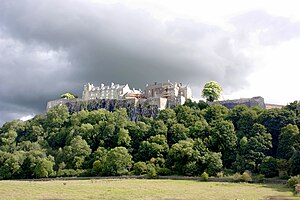Siege of Stirling Castle (1304)
| Siege of Stirling Castle | |||||||
|---|---|---|---|---|---|---|---|
| Part of the First War of Scottish Independence | |||||||
 Stirling Castle in 2009 | |||||||
| |||||||
| Belligerents | |||||||
| Kingdom of Scotland | Kingdom of England | ||||||
| Commanders and leaders | |||||||
| Sir William Oliphant | King Edward I | ||||||
| Strength | |||||||
| 30 men | 12 siege engines | ||||||
After the Battle of Falkirk in 1298, it took Edward I six years to gain full control of Scotland. The last stronghold of resistance to English rule was Stirling Castle. Armed with twelve siege engines, the English laid siege to the castle in April 1304.[2] For four months the castle was bombarded by lead balls (stripped from nearby church roofs), Greek fire, stone balls, and even some sort of gunpowder mixture. Edward I had sulphur and saltpetre, components of gunpowder, brought to the siege from England.[3]
Impatient with the lack of progress, Edward ordered his chief engineer, Master James of St. George, to begin work on a new, more massive engine called Warwolf (a trebuchet). The castle's garrison of 30, led by William Oliphant, eventually were allowed to surrender on 24 July after Edward had previously refused to accept surrender until the Warwolf had been tested.
Despite previous threats, Edward spared all the Scots in the garrison and executed only one Englishman who had previously given over the castle to the Scots.[4] Sir William Oliphant was imprisoned in the Tower of London.
References
[edit]- ^ M. Morris, A Great and Terrible King, 343
- ^ Ronald McNair Scott (1982), Robert the Bruce King of Scots, London: Hutchinson & Co
- ^ "Castles and sieges", Foghlam Alba
- ^ Marc Morris: Edward I, A Great and Terrible King
